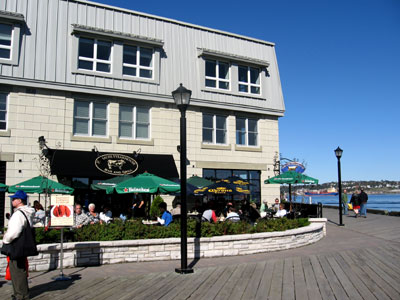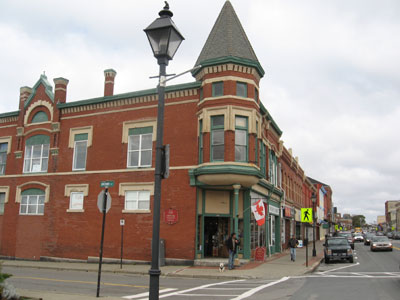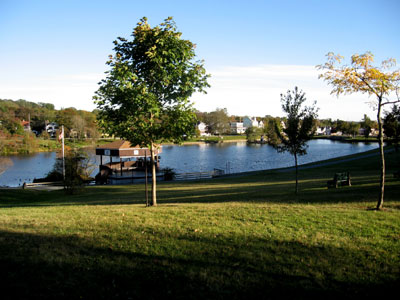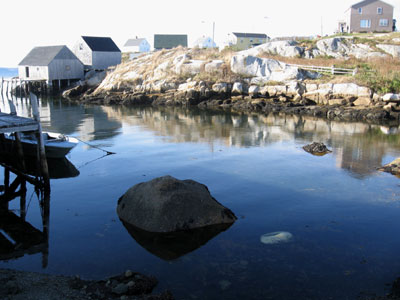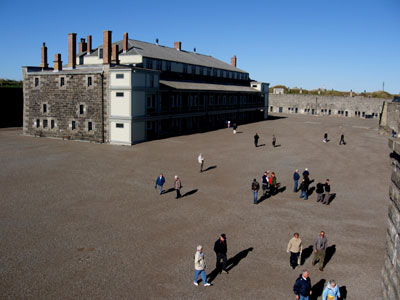The Research Centre also provides public reference for all ocean immigration records from 1925 to 1935 and many Canadians specifically come to Pier 21 to research their parent’s or grandparent’s arrival records in Canada. Four computer terminals provide access to the website, to the stories database, the ship database and other electronic resources related to immigration. Microfilm records contain the responses to 28 questions that a prospective immigrant would have to answer prior to being allowed to enter Canada. These microfilms are some of the most popular records in the Research Centre.

Images of ships that brought immigrants to Canada
Although I have no personal connection to Pier 21, having arrived by myself in Toronto without family in 1986, Carrie-Ann Smith, Pier 21’s Manager of Research, provided me with a copy of the entire chapter on German and Austrian immigration, taken from the Encyclopedia of Canada’s People’s, edited by Paul R. Magocsi, and published in 1999 by University of Toronto Press. I found out that about 31,000 Austrian immigrants came through Pier 21 from 1928 to 1971, compared to 1,152,400 immigrants from the United Kingdom and 527,000 immigrants from the United States. In addition to 48,000 War Brides and their children, many refugees and displaced persons also came to Canada during these years, including about 69,700 Jewish immigrants, many of whom were victims of the Holocaust. In addition, Canada also welcomed about 3,000 Evacuee Children from the United Kingdom who were evacuated during WWII due to the heavy bombing raids and the perceived threat of invasion. More than 250,000 children were supposed to be evacuated, but one of the ships transporting children was sunk by enemy ships so the program was cut short.
Another category of immigrant were the Home Children: more than 100,000 left Great Britain between the late 1860s and the mid 1930s due to the extreme poverty in their home country. These children would typically be employed either as domestic help or farm labourers, and the practice was already dwindling when Pier 21 opened in 1928. Stories representing the almost half a million WWII veterans who embarked for military service in Europe from Pier 21 during the Second World War, can also be found here. The human stories of so many different types of people provide fascinating insights into one of the most turbulent times of human history and Canada’s role in it.

Pier 21 is certainly one of Canada’s most unique museums, testimony to the key role that immigration has played and continues to play in this country. You enter the museum and arrive in a large exhibition hall, the Kenneth C. Rowe Heritage Hall, a multi-purpose area that can also be rented out for private functions which holds up to 600 guests. Up the elevators you arrive in the main exhibit area which features a wide variety of exhibits illustrating the immigration experience. The Rudolph Peter Batty Exhibition Hall allows you to retrace the steps of an immigrant who just arrived at the Halifax Harbour, complete with wooden waiting benches and an immigration officer’s desk. The Wall of Ships features images of many of the ocean liners that used to transport thousands of immigrants to their new home country. A replica of a Canadian National Railway car conjures up memories of the train journeys that so many immigrants took across Canada to their new homes in different parts of the country.

Six video booths provide access to video clips featuring the story of immigrants from different places. As a Canadian immigrant from Austria, I sat down in the first video booth where an Austrian video testimonial was being played and I saw the story of an Austrian immigrant , a man who had come to make his life in Canada in the 1950s. His emotion and gratefulness to his new country were clearly visible.
The Andrea and Charles Bronfman In-Transit Theatre at the far end of the exhibition space features a 24 minute virtual projection presentation that portrays the emotional stories of those who passed through these historic halls. Stefani pointed out that the volunteer guide who was supervising the presentation was a very special person: Robert Vandekieft is an 89 year old individual who volunteers at Pier 21 three days a week. But not only does Robert give his personal time to this unique museum, he actually came through the doors of Pier 21 as an immigrant himself in 1954 to start his new life in Canada.

Robert Vandekieft, Pier 21 volunteer and Canadian immigrant
Robert originally is from Haarlem, a town in northern Holland and decided to make his new life in Canada. Three months after his arrival in 1954 his wife and children followed. Robert fondly recalls a story of his family’s arrival: he had bought a teddy bear for his older son and upon arrival tossed it up to the top level of the ship where the boy successfully caught it. He had also bought some plastercene for his younger son as a present which he tossed up towards his younger child.
Unfortunately his throw was off and the plastercene fell into the water, but thanks to the kindness of the longshoremen of the Halifax Port, they fished it out of the water and brought it back to Robert so he would be able to give his younger son a proper welcome gift.

The created immigration waiting hall at Pier 21
Robert had originally travelled to Winnipeg where he was hired as a fur dyer, his original occupation. But he did not like his job there very much, so after a few weeks he travelled back to Nova Scotia where he was offered a job on a farm. After his family’s arrival Robert found out that his wife was not at all keen on farming so he looked for another job. He started working for Canada Packers in the warehouse and would regularly lift sides of beef with a weight of up to 62 pounds.
After 8 months he applied for a job as a stagehand with the CBC (Canadian Broadcasting Corporation), then he moved up in the ranks to crew header and later to become the supervisor of the design department. As his career progressed, Robert Vandekieft became a producer and director at the CBC and his career ended with senior roles in educational television. One of Robert’s last shows before his retirement was a 5-part series on the Mi’kmaq First Nations People filmed in their native language. What a Canadian success story!
Obviously this man at almost 90 years of age is able to look back on a long and interesting life of which he has spent 52 years in Canada. I asked Robert what he thought about Canada and his face lit up with a huge smile: “I love this country!”

Halifax Harbourwalk
Robert has been honoured as the “Maritimer of the Week” and he smiles when he says that his granddaughter nominated him. He loves volunteering for Pier 21 and has been doing it for almost five years now.
Although my visit at Pier 21 was cut short because of my tight schedule (I still needed to see Dartmouth on my last afternoon in Nova Scotia), I was touched by all the human stories of Pier 21, represented first and foremost by the living testimonial of Robert Vandekieft, who, like thousands of others, turned his arrival at Pier 21 into the first step of a long and successful life in Canada.
